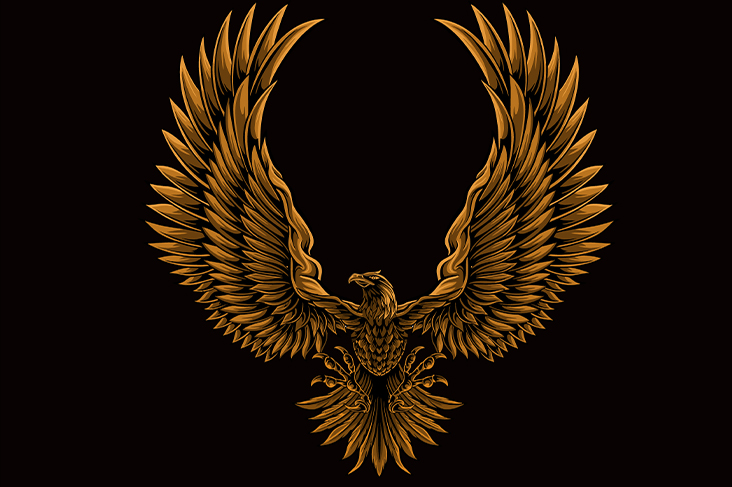The Aetos Kaukasios, or Caucasian Eagle, was a legendary bird that the Ancient Greeks believed existed in their mythological world. The Eagle was a prominent bird in Greek mythology, one of the emblems of the Greek deity Zeus.
However, the Caucasian Eagle was a unique bird due to its enormous size and exceptionally long lifespan.

It gained notoriety for its part in Prometheus’s punishment of the Titans.
In this piece, we explore the life and story of the Caucasian Eagle.
Caucasian Eagle
The Eagle was a prominent symbol in Greek mythology because it was considered a sacred creature to Zeus. The supreme deity of Greek mythology was known to assume the form of an eagle on some occasions. For example(such as when he kidnapped Aegina) and uses eagles (such as by having them carry his thunderbolts).
Many ancient texts, such as Hesiod’s Theogony, Pseudo-Apollodorus’ Bibliotheca, Apollonius Rhodius’ Argonautica, and Aeschylus’ Prometheus Bound, mention the Caucasian Eagle, which was not a regular eagle despite being used by Zeus.
Origin
It was often believed that the Caucasian Eagle, along with other legendary beasts like the Nemean Lion and the Lernaean Hydra, descended from Typhon and Echidna.
However, many believed that the Caucasian Eagle was, in fact, the offspring of Tartarus and Gaia, which would make it a sibling of both Typhon and Campe.
It was suggested that the Caucasian Eagle wasn’t a real bird but rather an automaton built by Hephaestus, the god of forge and fire. The creature didn’t seem quite as hideous as the offspring of Typhon and Echidna or Tartarus and Gaia.
Like the Nemean Lion and the Lernaean Hydra, the Caucasian Eagle got its name from the region in which it was found in the wild: the Caucasus Mountains.
The Punishment of Prometheus
Because of its part in Zeus’s punishment of Prometheus, the Titan, the Caucasian Eagle gains notoriety in Greek mythology.
After the Titanomachy, Prometheus formed humanity from clay and endowed it with the talents of the Olympian gods. He then stole the secret of fire from Hephaestus’ workshop.
Once Zeus realized that the Titan had shown humanity how to maximize the efficacy of its sacrifices to the gods, he became enraged and decided to exact revenge.
Caucasian Eagle And Prometheus
Hephaestus then fashioned indestructible shackles and used them to fetter Prometheus to the immovable Caucasus Mountains.
Then, to add insult to injury, the Caucasian Eagle would feast daily on Prometheus’ liver, as the Titan’s liver would regenerate overnight. However, because Prometheus was eternal, the suffering caused by the Caucasian Eagle’s acts would last forever. He would never really die from having his liver removed.
Given the time it took for Prometheus to be punished and considering that the daily feast of the Caucasian Eagle was mentioned by the Roman author Hyginus in Fabulae. We may safely assume that this bird has a very long lifespan.
Although no other author was willing to do so, tradition holds that Prometheus was imprisoned before the Deluge, from where he advised his son Deucalion, who saw Prometheus afterward. The Argonauts, many generations later, heard the Titan’s screams of suffering and saw the Caucasian Eagle.
Heracles And The Caucasian Eagle
Like most of Echidna and Typhon’s progeny, the Caucasian Eagle met its end at the hands of a Greek hero, which meant that Prometheus’ punishment and the Caucasian Eagle’s existence had ended.
Heracles, a demi-god and Zeus’s human son, was the Greek hero in this story. However, Heracles did not just kill the Caucasian Eagle; he first asked his dad for permission to kill the bird and then freed Prometheus.
Heracles gave Zeus the centaur Chiron’s immortality in return (Chiron was in excruciating agony at the time). While Zeus didn’t need immortality, he accepted the offer. But, of course, Zeus had a soft spot for Heracles. He knew his son’s reputation would soar once he freed Prometheus and slew the Caucasian Eagle.
Heracles would travel to the Caucasus Mountains after approval from Zeus and wait for the massive Eagle to fly overhead. As soon as the Eagle was within range, the Greek hero would let fly with his entire quiver of arrows, bringing the bird falling to the ground dead.
Heracles and Prometheus joined forces and were able to shatter the Titan’s shackles, liberating him from his torment.
The Death Of Caucasian Eagle
Consequently, Heracles waited patiently in the Caucasus Mountains for the enormous Caucasian Eagle to soar above. Then, after appealing to Apollo for a perfectly aimed arrow, Heracles let out a volley of poison arrows. The Caucasian Eagle was shot down mid-flight, and the hands hit their targets.
Afterward, Heracles and Prometheus could use their combined might to smash the shackles that Hephaestus had forged to imprison Prometheus.
Although various eagles in Greek mythology were also cited as the genesis for this cluster of stars, accounts claim that Zeus ultimately placed the Caucasian Eagle among the stars in Aquila’s constellation.
The Bottom Line
It is common to find a Caucasian eagle-like creature in ancient Greece, Georgia, and Circassia myths. As a representation of Zeus and other gods of the sky, the Eagle was held in high esteem by the ancient Greeks.
The ancient Greeks believed that the Eagle’s ascension to godhood was a sign of Zeus’s favor and triumph. Among the several mythological eagles featured in Greek mythology, the Aetos Kaukasios, or Caucasian Eagle, is the most well-known symbol of bravery and might.
